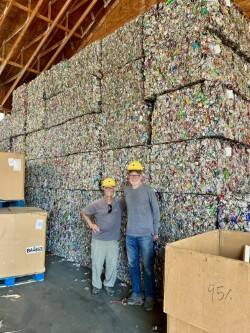Submitted by the Lopez Solid Waste Disposal District
News reports about recycling can be depressing, with frequent revelations of how little purportedly recyclable material is in fact recycled. The good news is, it’s so much better on Lopez.
Unlike larger municipalities where the waste stream is commingled, at the Lopez Dump our community successfully goes to great lengths to sort recyclable materials. For example, Lopezians conscientiously minimize food contamination while:
sorting plastics into three types; isolating aluminum cans from their “tin” counterparts; placing cardboard on the conveyor and mixed paper in its own bin; facilitating reuse of egg cartons and paper shopping bags; dumping glass in individual dumpsters; and isolating different kinds of metals (aluminum, brass, stainless steel, copper, electric wire, appliance steel, lead, zinc).
These efforts substantially increase the value (in dollars!) of recycled products. As a result, what Dump users pay is reduced and, equally important, a greater variety of material is in fact recycled.
This all came home when members of the LSWDD (The Dump) Board of Directors were treated to a tour of the Skagit River Steel and Recycling center in Burlington. Skagit River Steel takes seriously their motto of good environmental stewardship by minimizing trash going to landfills. Recyclable materials from the Lopez Dump are trucked to the Skagit River Steel facility (the truck from the Lopez Dump was offloading while we were there). Skagit Steel General Manager Todd Reynolds spent over an hour guiding board members around the sprawling eleven-acre site, carefully explaining how each type of material is processed for later reuse.
While the Lopez Dump prides itself in the care it takes in separating refuse and minimizing contamination, what we do is only the beginning of the isolation process. For example, a group of Lopez volunteers (aka The Metal Dogs) disassembles items in the metal recycling bins, including identifying two types of aluminum scrap. At Skagit Steel, aluminum is further divided into at least a dozen additional categories according to purity, each with a different return in value.
The same applies to the other types of material shipped from the Lopez Dump:
Copper and aluminum electrical wire is divided into another dozen types. The plastic outer coating is mechanically stripped via at least two different processes depending on thickness and make up. The outer coating is never burned but is instead disposed as garbage.
Other metals are sorted by type and purity, e.g., one large cardboard tote contained nothing but brass bullet shell casings.
Mixed paper and cardboard, which are baled at the Lopez Dump, are not diverted to landfills. They are eventually shipped to Port Townsend or Port Angeles and processed into paperboard. Although the Lopez Dump pays to send mixed paper to Skagit River Steel, patrons at the Dump are not charged for mixed paper. This practice is unlike other local facilities that deal with mixed paper as garbage. The costs of baling and shipping mixed paper are underwritten by the annual Dump levy while at the same time reducing tipping fees to Dump patrons.
Glass at Skagit Steel is crushed, then sent to a bottling plant in Seattle. On Lopez, glass is disposed of on island at no additional cost to patrons. The expense is again underwritten by tipping fees and the annual levy, unlike nearby facilities that charge additionally for glass.
Aluminum cans are recycled directly into new aluminum cans.
Plastic is again separated by type, is baled, and shipped to various facilities. It then goes through a variety of processes, not unlike the fractionation of the oil from which it originated. Importantly, Reynolds emphasized that their products are recycled domestically, avoiding the disturbing scenes of overseas facilities where tons of plastics and other materials are burned, generating clouds of toxic waste.
Vehicles are drained of all fluids (fuel, motor oil, coolant, transmission and brake fluid) before being crushed. They are then added to the mountains of “steel” (too many types to mention) bound by train or truck to smelters for repurposing.
The result of this meticulous parceling of waste is gratifying. Skagit River Steel recycles over 99% by weight of deposited materials, less than 1% eventually entering the waste stream!
Reynolds was very complimentary of Lopez efforts at recycling, emphasizing that deliveries from Lopez are exceptionally free of contamination. This increases their value both to the Lopez community and to Skagit River Steel’s bottom line. A definite win-win in an otherwise, sometimes depressing world where efforts at recycling often fall short of expectation.



